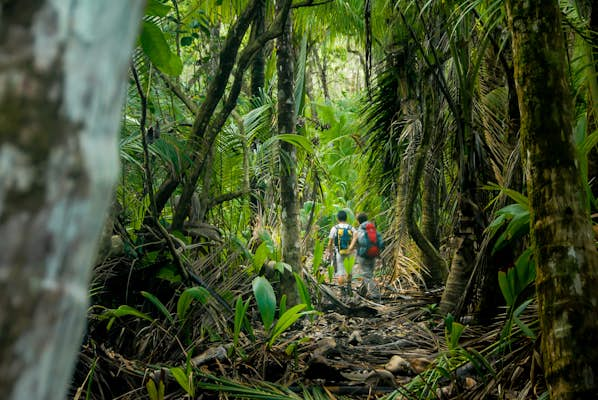


10 places for discovering the best of amazing Algeria
Full of surprises, epic Algeria is an adventurous traveler’s dream.
Africa’s largest country by area has a 1600km (994-mile) coastline fringed with long sandy beaches and dotted with history-rich cities which include some of the best Roman ruins in the world. Inland, a fantastic desert hinterland promises authentic oasis towns, vast sand seas and ancient volcanic mountains covered in rare prehistoric petroglyphs and paintings.
Until recently, Algeria was one of the hardest countries in the world to visit. But this is changing, with tourist visas getting easier to obtain (still, budget two months for the process), and an increasing number of flights from Europe, the Middle East and Africa.
Curiosity piqued? Read on for 10 places you’ll want to visit in this country, a travel destination that will soon get the attention it deserves.

1. Timgad
Best for fans of epic Roman ruins
The UNESCO-listed Roman ruins at Timgad were built by the emperor Trajan in 100 CE. The site sits at a crucial pass through the Aurès Mountains, a strategic point that gave Rome control of access to the Sahara. Often called North Africa’s Pompeii, Timgad an exemplar of Roman urban planning, the city laid out like a chessboard over 50 hectares (123 acres). You’ll need a full day to explore all the forums, temples, markets, bath houses, theaters, law courts and villas here, as well as a rare public library. Look out for the inscription in the forum which reads “venari lavari ludere ridere occ est vivere” (“to hunt, to go to the bath, to play, to laugh: this is to live”). The on-site museum has 200 stunningly well-preserved floor mosaics.
Planning tip: Timgad is a very exposed site. You’ll need a hat and plenty of water in summer, and a jacket in winter or spring as it can be cold and windy.

2. Constantine
Best for admiring one of the world’s most improbably sited cities
Since the 4th century BCE, Constantine has occupied a rocky pinnacle above the river Rhumel, encircled by 200m(656ft)-deep ravines. It’s a pleasure to admire the ingenuity behind this improbably located city – and to snap pictures from the Sidi M’Cid Bridge and the Monument aux Morts, a WWI memorial that offers a bird’s-eye view. Once you hit the streets, you can visit the finely decorated Ottoman Palace of Ahmed Bey, the National Museum and the beautifully contemporary Emir Abdelkader Mosque, one of the largest on the continent.
Planning tip: Non-Muslims are allowed to enter mosques in Algeria outside of prayer times, so plan your touring accordingly.

3. Annaba
Best for following in the footsteps of North African Christian pioneer
Charming Annaba is where Amazigh theologian St Augustine – a figure crucial to and “Father” of the Catholic Church – taught and wrote works that remain cornerstones of modern Christian theology. Augustine was bishop of Roman Hippo Regius, now a flower-filled ruin in the town suburbs. On a hill above is the Basilica de Saint Augustine, built by the French in the late 19th century and overlooking the Basilica of Peace, where Augustine taught and beneath which he was buried. It is still tended by Annaba’s Augustinian community and a site of Catholic pilgrimage.
Planning tip: Underrated Annaba has a beautiful seaside setting, an atmospheric old town and some lovely sandy beaches.

4. Tassili n’Ajjer National Park
Best for taking in the world’s oldest gallery of art
Tassili N’Ajjer National Park encompasses 72,000 sq km (27,800 sq miles) of extraordinary desertscape, characterized by a surreal sandstone rock forest covered with 15,000 prehistoric petroglyphs and carmine-colored rock paintings depicting herds of elephant, giraffe and buffalo. These images provide a reminder of the Saharan steppeland, where Neolithic pastoralists roamed alongside wild megafauna some 10–15,000 years ago. To see all of Tassili’s treasures, you’ll need a full 10 days, though tours of 5 or 6 days are also possible.
Planning tip: Remote Djanet (served by Air Algérie) is the gateway to the Tassili n’Ajjer National Park. Officially, travelers touring the desert require an agency escort/guide for security.

5. Algiers
Best for discovering a capital with character
Overlooking a beautiful crescent bay, Algeria’s capital city brims with atmosphere, interesting Ottoman and art deco architecture and cafes playing haabi – the Muslim-Jewish fusion style forged in the city’s ancient alleys. Algiers’ historic heart, the Casbah is a snakes-and-ladders labyrinth of staircases, antique palaces and mosques. After occupying the city in 1830, French colonists encircled Algiers with Parisian-style boulevards; added a botanical garden, the Jardin d’Essai; inaugurated the Bardo National Museum; and built the basilica of Notre-Dame d’Afrique. The Martyrs Monument, Maqam Echahid, bookends the south end of the city, commemorating those who died during the long fight for independence, finally achieved in 1962.
Planning tip: Explore the Casbah with a guide from Fancyellow. If you have time, take a day trip to the extraordinary Roman ruins of Tipasa and Cherchell.

6. Tlemcen
Best for rich medieval architecture
Tlemcen is an architectural jewel of medieval mosques and palaces set in a green pine forest. In the 12th and 13th centuries, the city was a hub of learning and trade that rivaled Fez, Tunis and Granada, trading gold from Timbuktu and salt from Taghaza with Europe. This explains the hybrid Hispano-Moorish architecture of the Great Mosque (1082), an Almoravid masterpiece, and the El Mechouar citadel, which echoes Spain’s Alhambra. On the western edge of town you’ll find the ruins of the military camp El Mansourah (1299), with a 40m(131ft)-high minaret that is near-twin to the Giralda in Seville.
Detour: Tlemcen remains spiritually significant due to the tomb of Sidi Boumediene, located 1.6km (1 mile) southeast of the city. From here, it’s a 10-minute drive to the El Ourit waterfalls and a half-hour drive to the stalactite-encrusted Grottes des Beni Add.

7. Ahaggar National Park
Best for feeling like you’re at the edge of the world
Older than Tassili, the Hoggar Mountains of Ahaggar National Park are volcanic basalt buttes that rise vertiginously from the desert floor. Ancient river valleys sweeping through them on their way to Lake Chad are lined with more petroglyphs and paintings of wild animals and charioteers, thought to be the Garamantian ancestors of the Tuareg tribespeople. Week-long camel treks and 4×4 tours depart from Tamanrasset to the high plateau of Assekrem (2728m / 8950ft) – which translates to “the end of the world.” Stay at the hostel to see a truly spectacular dawn over the Atakor massif.
Planning tip: Expect to tip guides and drivers the equivalent of an extra day’s payment for each week worked.

8. Ghardaïa and the M’Zab Valley
Best for seeing secretive desert citadels
A collection of five ksours (citadels) built between 1012 and 1350 ( collectively referred to today as Ghardaïa after the principal one), the Pentapolis in the M’Zab Valley is one of the most fascinating places in Algeria. The fortified cities are today inhabited by Mozabites, members of an Amazigh tribe who adhere to the conservative Ibadite sect, observing distinct social codes and clothing, and permitting entry to outsiders only with a chaperone. Engage a guide to explore these closed communities to see, for example, the Sidi Brahim mosque in El-Atteuf, which inspired Le Corbusier. Don’t forget to check out the carpets in Ghardaïa’s market: weaving is a traditional craft here.
Planning tip: To visit Ghardaïa, the government requires tourists be on a group tour with required permits; try Algeria Tours. Within the ksours, you’ll also need to respect community rules, which include modest dress, no smoking and no pictures of people.

9. Sétif & Djemila
Best for gorgeous ancient mosaics
Sétif’s archaeological museum houses some of the best Roman mosaics in the world, including the unrivaled Triumph of Dionysus. Most artifacts come from Djemila (previously Cuicul), a UNESCO-heritage Roman city which sits on an scenic hillside in the Petit Kabyle mountains – and which is an essential excursion. You can tour the lovely ruins in half a day, but you’ll probably want to linger longer to enjoy the picturesque views. An excellent on-site museum exhibits incredible mosaics that cover almost the entire wall space.
Planning tip: Djemila is most easily visited from Sétif (1 hour) or Constantine (1 hours). Stay at Hotel Tadj el Mouada in Setif or Novotel Constantine.

10. Timimoun
Best for oasis life and dune-bashing
Timimoun in Central Algeria is a spectacular desert oasis set at the edge of an escarpment overlooking a sebkha (salt pan) and the undulating dunefields of the Grand Erg Occidental. Since this stunning landscape is miles from anywhere, you’ll feel like you’ve landed on the moon, with the red town rising from the earth like a wind sculpture. From here, you can (and should!) head into the desert. Most hotels can arrange quad biking and sandboarding close to town. Or you can tour the Sebkha Circuit, which takes you to abandoned villages crumbling in the heat on a roller-coaster ride over towering dunes.
Planning tip: Timimoun’s S’Boue Festival lasts seven days and draws thousands who come to celebrate at the mausoleum of Sidi El Hadj Belkacem and enjoy sacred music, poetry and traditional dances.

The best places to visit in October 2024
You don’t have to stop traveling just because the year is ending. October is one of the best times for many epic adventures. Whether you want to get active in Montenegro or wander a medina in Morocco, here are the best places to travel in October.
Where are the best places to travel to in October for relaxation?

Menorca, Spain
Why now? Swim, cycle and stroll in “winter’s spring.”
Most sunbathers go home when summer’s high heat ends. But there’s still plenty of sun in Menorca. Early fall is sometimes called primavera l’hivern, or “winter’s spring,” thanks to the bright, warm days. Tourist spots are still open, but you’ll have many locations to yourself. And the Mediterranean sea lapping Menorca’s wild beaches feels quite warm. There might be a few showers, but you’ll have fun exploring the Anglo-Spanish heritage in Ciutadella and in the capital city Maó (Mahón). Marvel at 4000 year old megalithic monuments and hike or bike the coast on 185km (115=mile) Camí de Cavalls. The wetlands in Parc Natural S’Albufera des Grau are a haven for birds and Menorca is a Unesco Biosphere Reserve. Pack binoculars, indulge in Menorcan pastries and explore this corner of Europe in peace.
Seychelles
Why now? Calm seas in paradise.
Seychelles is probably how Pixar would draw paradise: swaying palms, supernaturally blue seas, white sand, artfully scattered with boulders, plus a few cute turtles crawling ashore. Fantasy made real. There’s no bad time to visit this island nation for swimming, snorkeling and diving thanks to the balmy 25–30°C (77–86°F) average temperatures year round. But October is cheaper than the peak summer months. Go to Mahé, the largest island, for beaches like Beau Vallon and Anse Royale, plus rainforests and rare birds in Morne Seychellois National Park. The capital city Victoria is full of markets, Creole buildings and unique sights. The Indian Ocean water can be 29°C (84°F), visibility is around 30m (100ft) and it’s an ideal time for spotting migrating whale sharks.
Where are the best places to travel to in October for outdoor festivals?

New Mexico, USA
Why now? For cooler weather, indigenous culture and hot air balloons.
New Mexico is very enchanting in sunny, mild October. High temperatures are over and the 20°C (68°F) days are ideal for discovering the historical riches and outdoor celebrations. Explore the region’s Native American origins at the 1000 year old Taos Pueblo. Spanish missionaries founded Santa Fe in 1610, and the capital city has its own style. It’s a mix of old adobes, Spanish Pueblo Revival design, and modern-art galleries. Go to the Institute of American Indian Arts’ Fall Powwow for authentic crafts and dance performances. The lively Indigenous People’s Day Weekend Celebration unites dancers, musicians and artisans from many tribes and nations. The Albuquerque International Balloon Fiesta may take your breath away as hundreds of hot air balloons in a rainbow of colors gently ascend over the Rio Grande Valley.
New South Wales, Australia
Why now? Talk to the animals and enjoy quirky festivals.
Sun, sand, surf and scuba schooners – standard-issue beach fun awaits along the Pacific Highway, the justifiably well-trodden trail between Sydney and Brisbane. But veer a little inland to discover unique natural experiences and cultural festivals. Get up close with koalas, dingoes and raptors at Lone Pine Koala Sanctuary. Buddy around with a binturong, a rare mammal that smells like popcorn, at Hunter Valley Wildlife Park. Or trek through a rainforest and feed the neon colored wild parrots at the Currumbin Wildlife Sanctuary. October festivals lineup includes the Griffith Spring Fest where sculptures made from thousands of locally grown oranges and grapefruits are a big draw. Stop and smell the lilacs and other blooms at the Goulburn Lilac City Festival. Head to the Kangaroo Valley Folk Festival two hours from Sydney for live music, dance and poetry.
Where are the best affordable places to travel to in October for culture?

Fez, Morocco
Why now? October is the area’s weather sweet spot.
Stepping through blue-tiled Bab Bou Jeloud is as close as most of us will get to time travel. It feels like going back 1200 years to a city without motorized traffic. Welcome to Fez, the largest and most mesmerizing and extensive medieval city in the Islamic world. Visit in October, the best month for Mediterranean climate and mild weather. It’s normal to get lost as you explore the 9400 alleys in Fes el-Bali, the oldest section of the walled medina. Admire glorious Moorish zellij tile, ornately carved wood and alabaster on medersas (Islamic colleges). Feast on pastilla (spiced chicken pie), tagine stews and a traditional glass of mint tea. The plethora of tasty, inexpensive street food available is perfect when traveling on a budget. At night, bed down in an Arabian Nights–worthy palace, riad or dar (courtyard mansion). But be ready for the intense noise from the souks (bazaars) and strong aromas from the colorful tanneries.
Oaxaca, Mexico
Why now? Día de Muertos is unforgettable in this diverse wonderland
For an unforgettable cultural experience, go to Oaxaca City for Día de Muertos. Yes, there are lots of visitors this time of year. But it’s a mostly dignified and joyous observance welcoming departed loved ones. Marvel at family and community displays made of marigolds, corn, candles, personal artifacts and decorative skulls. Oaxaca is also the home of mezcal and mole; you’ll find both at Mercado Benito Juárez, plus handmade products from nearby villages. Shop for affordable crafts including glazed green kitchen pottery, fanciful carved creatures called alebrijes, embroidered clothing and handwoven rugs from Teotitlán del Valle. See the region’s most important plants at the Jardín Etnobotaníco de Oaxaca at Santo Domingo, and discover woven treasures at the Museo Textil de Oaxaca.
Where are the best places to travel to in October for food and drink?

Le Marche, Italy
Why now? Hunt truffles, wines and other tasty treats.
Foodies call Le Marche the next Tuscany because this “hidden” corner of Italy delivers great food and culture at good prices. The hillside vineyards and Renaissance buildings in walled cities Urbino and Ascoli Piceno may even remind you of Tuscany. But the people in Le Marche are not trying to be hip.. The region is pretty quiet and filled with low-key culinary gems. Seek out Verdicchio and Conero wines, mushrooms (fungi), local pasta, Prosciutto di Carpegna ham, and a creamy sheep and cow’s milk cheese called Casciotta d’Urbino. They are all amazing in harvest season. Autumn brings pleasant temperatures for hopping between medieval hilltop towns and hiking in Monti Sibillini National Park — maybe you’ll spot a chamois, wolf or bear. Tour beautiful wine villages such as Gradara and Offda. Eat your fill of white truffles at the fairs in Acqualagna and Apecchio, which also makes fine beers. Le Marche has many charms.
Tohoku, Japan
Why now? Make a food quest in the stunning harvest.
Most visitors to Japan head west from Tokyo towards Kyoto and Fuji, or go north to Hokkaidō. But you’ll be happy you took time to visit northern Honshū and Tohoku’s six prefectures. You’ll find steaming onsens (try Nyuto), gleaming castles (Hirosaki), and golden-halled temples (Chūson-ji in Hiraizumi). But our favorite locations may be the peaceful farming valleys and forest-clad mountains covered in red and gold. Harvest season is perfect for exploring the region’s edible riches: prized Iwata wagyu beef, fresh squid and mackerel, local takes on ramen, soba and udon noodles, apples and rice. Fukushima prefecture is called Sake Kingdom, so it’s the best place in the world to explore this drink. Fuel up for hikes among the cedars on Mt Haguro, through 8000 year old beech forests of mountainous Shirakami-Sanchi or along the 1000km-plus (621-mile) Michinoku Coastal Trail.
Where are the best places to travel to in October for fall foliage?
Rogue River Valley, Oregon
Why now? Pretty leaves, wine, cider and the Bard
The hills around Grants Pass have long been filled with dairies, vegetable farms, and orchards growing fruits like the giftable pears from Harry & David. The region is also known for wine, but that’s not the Rogue Valley’s only tipple. Blossom Barn Cidery turns heirloom pears into hard cider called perry. Perry is known as the champagne of ciders thanks to its fine bubbles and delicate aromas. It pairs beautifully with food, including the zesty, award winning blue cheeses from Rogue Creamery. Go to the Rogue Gorge Trail for a great time hiking near the dramatic Rogue River Gorge Falls framed by autumn leaves.
Trees aren’t the only plants that change colors in fall; grapevines do too. So it’s the perfect time to enjoy vineyard views while sipping wine. You’ll find crisp sparkling wines at Irvine & Roberts Vineyards, plus delicious orange Gewurztraminer and views at Weisinger Family Winery. Plaisance Ranch is a working cattle ranch and winery. You’ll enjoy the owner’s warmth and his range of well-priced wines that pair with their organic beef.
Ashland’s world famous Oregon Shakespeare Festival is going strong in October, so grab tickets and enjoy a bit of the Bard. The theater is next to Lithia Park, a 93-acre area filled with ponds and hundreds of maple, ash, dogwood and cedar trees turning gold. You’ll find fall foliage bliss walking the trails and paths. After a long day, unwind with a dip in the mineral springs baths and pools at Lithia Springs Resort, a popular destination.

Montenegro
Why now? Mix hiking with leaf-peeping
Don’t pack away your hiking boots just yet. The southern mountains of Montenegro are awesome for hiking over the summer months and into October. Durmitor National Park has 48 peaks over 2000m (6065ft) including the country’s highest: Bobtov Kuk (2523m/8277ft). These mountains are scattered with pines, lush meadows and glittering glacial lakes. They’re also home to wildlife, from birds to bears. The nearby Piva River Canyon is even more striking in fall, as the azure water winds through hills covered in orange, red and gold trees. There’s also family-friendly hiking amid the peaks and primeval forests of Biogradska Gora National Park. Our editors suggest a week climbing Rumija on the south coast and hiking in the Kučka Krajina range near capital Podgorica. Hike mountains Orjen and Lovćen for prime views of the Adriatic, and then cool off with a swim.

Take a day trip from Stockholm to visit palaces, islands, Viking sites and more
There’s a profusion of exciting things to see in the city of Stockholm. And once you expand your radius from Gamla Stan, you can add country palaces, windswept islets, dynamic towns and Viking culture to the mix, via easy day trips.
The Stockholm region is easy to drive around and even easier to explore on public transport. Conveniently, SL Travelcards allow unlimited travel on all buses and local trains in the area, making exploring the region a seamless breeze.
From Drottningholm Slott to Vaxholm in the Stockholm Archipelago, here are the best day trips from Sweden’s capital city.

1. Immerse yourself in Swedish history at Uppsala and Gamla Uppsala
Travel time: 40 minutes to 1 hour each way
A lively college town that’s rich in history, Uppsala is one of Sweden’s oldest cities, dating back to the 3rd century. It’s also next-door to one of the most important pre-Viking sites in the country.
The city’s 40,000 students create a youthful buzz that’s you’ll quickly feel in the numerous stylish-but-unpretentious cafes and bars. Cobblestone pathways thronged with bicycles lead to the banks of the river Fyris, which flows through the center of town. A squat, pink castle tops a hill above, with a royal garden stretching out below. Budding scientists will enjoy the Linnémuseet and adjoining botanical garden, a replica of famed botanist Carl von Linné’s workspace. History buffs will have plenty to absorb, starting with the treasure-filled Museum Gustavianum or the skyline-defining Domkyrka (Cathedral). But the big draw is Gamla (Old) Uppsala, just up the road.
A gorgeous, 2.5-mile (4km) bike ride north, this fascinating archaeological site was once a flourishing 6th-century religious center where – allegedly – human sacrifices took place. Its 300 mounds from the 6th to 12th centuries make it one of Sweden’s largest and most important ancient burial sites. You can learn more in the adjoining Gamla Uppsala Museum, or wander on your own, reading the informative plaques throughout the site.
If you feel like a strolling or cycling further, Eriksleden is a 3.75-mile (6km) “pilgrims path” between the cathedral in Uppsala and the church in Gamla Uppsala. Its namesake, Erik the Holy, become King of Sweden around 1150 – until the Danes beheaded him 10 years later. The story is that his head rolled down the hill; where it stopped a spring rose up. The main trail also provides access to a ridged wilderness hiking area called Tunåsen, with a panoramic viewpoint (follow signs along Eriksleden just south of Gamla Uppsala to “Utsiktsleden”).
How to get there from Stockholm:
SL commuter trains run frequently (every 30 minutes or more) from Stockholm’s Central Station and City Station to Uppsala’s central station, taking 40 minutes to an hour. Bus 801 goes frequently from Stockholm Cityterminalen to Uppsala station via Arlanda Airport in about 45 minutes. Buses for Gamla Uppsala leave from Stora Torget in central Uppsala.

2. Cruise through the Stockholm Archipelago to Vaxholm
Travel time: 50 minutes each way
Stockholmers tend to get misty-eyed when they talk about the Stockholm Archipelago. And understandably so: in and around these islands lie little red wooden huts and cabins, deep forests, rocky beaches and low slabs of rock dotted with sunbathing Swedes. They’re a must-visit if you’re in the capital in the warmer months.
The count of specks ranges from 14,000 to 100,000 (the general consensus is around 24,000), with most uninhabited and/or not visitable. While many are quite far-flung, other islands with regular ferry service are much closer to the city center than many visitors imagine. The nominal “capital” of the archipelago is Vaxholm – which makes it a great place to start.
Visitors love the island’s sloping cobbled streets, candy-colored wooden houses, excellent restaurants (like the waterfront seafood mainstay Melanders Fisk) and idiosyncratic shops. The oldest part of Vaxholm, Norrhamn features an array of historic buildings, while the eye-catching art nouveau Waxholms Hotell rises over the waterfront. On a separate island just across from Vaxholm (and reached by frequent ferries) stands the imposting Vaxholm Fortress, built in 1544 to protect the Swedish capital and mainland.
How to get there from Stockholm:
Part of Stockholm’s public transport network, Waxholmsbolaget boats reach most of the visitable islands in the archipelago. Ferries leave from Stockholm’s Strömkajen; it takes around 50 minutes to get to Vaxholm. Most islands in the archipelago have good boat connections, provided you check schedules in advance.

3. Get the royal experience at Drottningholm Slott
Travel time: about 1 hour each way
The grand 17th-century palace of Drottningholm is home to the royal family for part of the year – and open for informative, 1-hour guided tours for visitors all year long (in English three times daily from June to August, and on weekends for the rest of year).
The tour will take you through the highly ornamented State Bedchamber of Hedvig Eleonora, with its opulent baroque interior (it’s the envy of everyone on Pinterest). The library of Lovisa Ulrika is a bright and impressive room, with most of its original 18th-century fittings intact (even if most of her 2000 books have been moved to the Royal Library in Stockholm for safekeeping).
Completed in 1766, the royal Slottsteater is in a remarkable state of preservation. Performances held here in summer still use the original 18th-century machinery to create dramatic effects (the wind machine is particularly impressive). At the far end of the royal gardens, Kina Slott is a lavishly decorated Chinese pavilion that features some of the finest rococo chinoiserie interiors in Europe.
The palace grounds are open for individual roaming, with the geometric gardens, set at an angle for maximum impact, worth the trip all by themselves.
How to get there from Stockholm:
Take the tunnelbana (metro) to Brommaplan, then change to the bus to Drottningholm. There’s also a well-marked bicycle path from the center of Stockholm to the palace (13km / 8 miles). In summer, regular boat services leave for Drottningholm from Stadshuskajen.

4. Discover Viking history at Birka
Travel time: 2 hours each way
On the island of Björkö in Lake Mälaren, the historic Viking trading center of Birka makes for memorable day trip. This UNESCO World Heritage site was founded around 760 CE to expand and control trade in the region. While not much remains today (other than a cemetery with some 3000 graves – and a beautiful Swedish island), the fun in visiting here is imagining the place bustling with traders and craftspeople centuries ago. The site also contains excavated remains of a defensive fort and the harbor.
If your imagination needs jump-starting, visit the superb Birka Museum, where exhibits include artifacts from the excavations, copies of the most impressive objects uncovered and a scale model of the village as it would have looked in Viking times.
How to get there from Stockholm:
Strömma Kanalbolaget runs round-trip cruises to Birka from Stadshusbron in central Stockholm. Since the trip takes 2 hours each way (the boat ride is glorious), plan on a full-day outing. Cruise prices include museum admission and a guided tour in English of the settlement’s burial mounds and fortifications.

The 8 best hikes in Central America
In the last couple of decades, the likes of Costa Rica and Panama have transformed Central America into one of the world’s adventure havens.
It’s a land scored by smoking mountains, threaded with coconut-dotted beaches and dressed from head to toe in jungles packed with sloths and slithering snakes.
This guide to eight of the region’s best hiking trails will hop from the wave-bashed Pacific to the untrodden reaches of the Darien Gap. The aim? To reveal Central America’s finest trekking paths and day hikes, with something for all levels, beginner to Bear Grylls.

1. Sendero el Perezoso, Costa Rica
Best for sloth viewing
1.3km (0.9 miles), 30 minutes, easy
Ask 10 people why they came to Costa Rica in the first place, and sloths are likely to feature somewhere in the answer. Cue this short detour off the main Park Trail in that ground zero of biodiversity, Manuel Antonio National Park, built to offer hikers access to some of the most sloth-rich jungles in the world – hence its name.
The Sloth Trail begins less than a 10-minute walk into the forest from the reserve’s main entrance. Take the spur that leads off to the west and follow the raised boardwalk pathways; soon you’ll be dwarfed amid phalanxes of silk cotton trees and buttonwoods.
They’re known to host two- and three-toed sloths, but spotting the critters can be tricky – they hardly make a move! Try to get on this one nice and early, because there are more sloths when there are fewer people.
The end of the trail connects to the main intersection for all routes through Manuel Antonio. That’s a great place to be, what with the cinnamon sands of Playa Espadilla Sur on one side and the route to the much-photographed scythe of powder at Manuel Antonio Beach on the other.

2. Volcán Concepción, Nicaragua
Best for a challenging long day-hike
16km (9.9 miles), 11 hours, challenging
Volcán Concepción is one of two cone-shaped summits that keep watch over Lago de Nicaragua, the largest freshwater lake in Central America.
It might not look it, but it’s doable in a single push; just leave early, because it’ll take 10 to 11 hours for most, and the cool morning air is a blessing on the initial ascent.
Speaking of ascents, the real killer here is the altitude gain. The summit is at a relatively mild 1610m (5282ft), but the base level of the hike is a mere 130m (427ft), meaning it’s a long way to the top. First sections are through lush jungle, and then you get a zigzagging mud track up the spine of the mountain.
The final leg above 1200m (3937ft) is trickier. That’s where the scree takes over, and there are steep parts where you might be asked to scramble against a vertigo-inducing backdrop of swirling lake waters and surrounding coffee plantations.
But there’s a reward: clear days at the top mean visions of a cloud-wisped crater rim. and even Mombacho Volcano far to the north.

3. Lost Waterfalls Trail, Panama
Best for waterfall lovers
3.3km (2.1 miles), 2-3 hours, easy
The good news is that none of the three waterfalls on this hike are lost, exactly. In fact, they’re pretty well known, as this is surely one of the most popular out-and-back routes in the eco mecca of Boquete.
The point is they feel lost, because you’ll need to navigate through Amazon-thick jungles woven with lianas and spiderwebs to reach them.
The waterfalls themselves are strewn almost equidistance along the route. The first is the biggest, a roaring cataract that froths over a ridge of wet stone.
The second is the place to swim – it gurgles into a deep and inky plunge pool. The third is like something out of a Jules Verne novel, framed by lush vines and colorful orchid blooms deeper in the Panamanian rainforest.
There is an entry fee for the Lost Waterfalls Trail and plus the taxi from Boquete. Wear sturdy, waterproof boots and bring a rain jacket for this one – it’s notoriously muddy and wet from start to finish.

4. Poás Volcano, Costa Rica
Best for staring right into a volcano
4.6km (2.9 miles), 2.5 hours, moderate
The whole of Central America is pock-marked with more volcanos than you can shake a hiking map at. One of the most accessible is Volcán Poás, in the heart of north-central Costa Rica.
It sits in a national park amid jungle-dressed peaks, about 50 minutes north of Alajuela and a 90-minute drive north of the capital, San José, making it prime day-trip territory.
There’s a visitors center at the trailhead where you can learn a little about the somewhat-disconcerting vulcanology of Poás – hikers brush aside the fact that it’s erupted 40 times since the 1820s and hit the path.
It initially runs east to Laguna Botos, the first of two crater lakes, passing through cloud forests rich in resplendent quetzals and hummingbirds.
The last ascent takes you to a high ridge some 2500m (8202ft) up. There, a 180-degree panorama reveals the second crater lake, Laguna Caliente, which sits broiling with sulfur and smoke in the crater of Poás itself. It’s actually the largest open crater on the planet, measuring a whopping mile from end to end.
5. Cerro Chirripó, Costa Rica
Best for seasoned trekkers
20km (12.4 miles), 2-3 days, challenging
Shouldering its way above the sierras and the clouds in southern Costa Rica, Cerro Chirripó is the highest peak in the land of Pura Vida. It’s a proper challenge that requires good fitness and some determination, taking two or three days on the mountain in all.
Even getting to the trailhead takes some effort, requiring an odyssey through the Cordillera de Talamanca to the tiny trekking town of San Gerardo de Rivas.
From there, it’s a full day’s walk up steep, rocky paths to the tin-roofed hut of Crestones Base Camp. That’s where things get really interesting, as day two brings sections of cloud forest and high-altitude paramo, a biome of rugged rosette plants and gleaming yellow wildflowers.
At the summit, some 3821m (12,536ft) above sea level, you can wonder at surrounding lakes and glacial valleys that are 20,000 years old!

6. Tiger Fern Trail, Belize
Best for seeing jaguars
5.5km (3.4 miles), 3-5 hours, moderate
If you can peel yourself away from the sugar sands of Belize’s cays and atolls, a wonderland of biodiversity awaits inland. Chief among the many reserves is the Cockscomb Basin Wildlife Sanctuary, which is precisely where you’ll find this moderately challenging out-and-back route weaving through primeval jungles.
The Tiger Fern Trail creeps through dense thickets of Belizean pine and broadleaves, occasionally cutting across a babbling creek on moss-caked rocks. It takes you deep into jaguar-conservation territory, so keep those eyes and ears peeled for big cats as you go.
Nearing the top, there’s a rustic campground with sweeping views of the Maya Mountains, along with a duo of waterfalls where you can cool off.
The best time to come is the dry season (December to April), when the trails are generally less muddy and the plunge pools much clearer.

7. Volcán Telica, Nicaragua
Best for overnighting by an active volcano
13.1km (8.2 miles), 1-2 days, moderate
You can climb Volcán Telica in León, northern Nicaragua, in either one or two days. It’s not a terribly challenging route, starting with flat farm fields and then a steep push up the sinewy cone itself. It’s really all about the view at the top.
Looking out, you’ll see a sort of Nicaraguan Serengeti, sweeping west toward the Pacific in endless scrub fields dotted with the occasional mango tree, heat haze sitting low in the valley bottom. It’s the view into the crater you’ll write home about.
Peer down to see a smoke-belching hole, plumed in sulfur and wisps of ash. At night – and here’s the reason you might prefer to spend an evening on the slopes – it even burns red with hot magma and lava.
8. Pipeline Trail, Panama
Best for getting close to the jungle
6.1 km (3.8 miles), 2.5-3 hours, moderate
The Pipeline Trail is a straight valley walk through the Bajo Mono, the hiking playground just north of Boquete town in the heart of western Panama.
It’s actually named for the industrial pipe that joins the path at the trailhead, but it could just as well be for the closeness of the rainforest, which looms in like a tunnel as you really get going. Yep, it’s jungle on all sides here.
A symphony of emeralds and greens rises overhead to the canopy, the scent of decaying leaves abounds and you get a sense of snakes moving in the undergrowth.
Suddenly, you’ll be stunned by the appearance of the great Cenizo – a hulking tree that’s said to be over a millennium old. The finale is a ribbon-like waterfall that drops through a gap in the jungle-covered ridges above.

A Guide to Sea Moss and All of Its Natural Health Benefits
Be Well
Chic Food Supplements You Can Buy Now
In addition to a strict diet and regular physical training, models like Rosie Huntington-Whitely and Jourdan Dunn also take supplements. Ahead, three flagship products to get you started on a new path to wellness.



